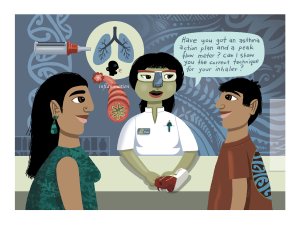Academic pharmacist Nataly Martini discusses the medical management of asthma in adults and adolescents, which has evolved to prioritise early anti-inflammatory treatment. She also explains how to improve patient outcomes by proactively identifying poor asthma control and supporting equitable access to education and treatment
CLASStime: Dizziness and vertigo

Nataly Martini provides a brief overview of selected causes of dizziness and vertigo, such as benign paroxysmal positional vertigo and vestibular migraine. Through case studies, she explains how these conditions may differ from serious clinical syndromes such as cervicogenic dizziness, highlighting the complexities, risk factors and management of these conditions
Kia ora and welcome to Pharmacy Today Kaitiaki Rongoā O Te Wā
Not a subscriber? Unlock this article by subscribing here.
1. Neuhauser HK. The epidemiology of dizziness and vertigo. In: Furman JM, Lempert T (eds). Handbook of Clinical Neurology, volume 137. Elsevier; 2016.
2. Mayo Clinic. Dizziness. 2022.
3. BPACnz. A delicate balance: managing vertigo in general practice. 2012.
4. Langmaid S, Durning MV. Why Am I Dizzy? WebMD, 2024.
5. Kerber KA. Dizziness in primary care. Prim Care 2024;51(2):195–209.
6. Hamiter M. Benign Paroxysmal Positional Vertigo. MSD Manual Professional Version, 2023.
7. Villar-Martinez MD, Goadsby PJ. Vestibular migraine: an update. Curr Opin Neurol 2024;37(3):252–63.
8. Reiley AS, Vickory FM, Funderburg SE, et al. How to diagnose cervicogenic dizziness. Arch Physiother 2017;7:12.
9. Agus S, Benecke H, Thum C, Strupp M. Clinical and demographic features of vertigo: Findings from the REVERT registry. Front Neurol 2013;4:48.
10. Byrne M. Assessment of the dizzy patient. Australian Family Physician 2002;31(8):1–6.





